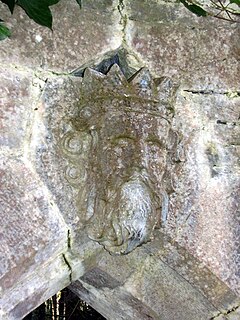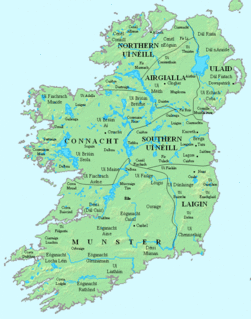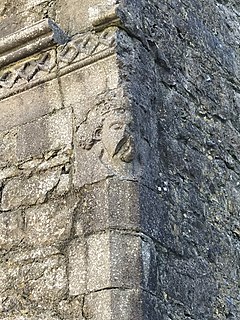
Ruaidrí mac Tairrdelbach Ua Conchobair was King of Connacht from 1156 to 1186, and High King of Ireland from 1166 to 1198. He was the last High King of Ireland. Anglo-Normans invaded Ireland. Ruaidrí was the last native and Gaelic King of Ireland.

Uí Fhiachrach Aidhne was a kingdom located in what is now the south of County Galway.

West Connacht was a kingdom of Gaelic Ireland, associated geographically with present-day County Galway, particularly the area known more commonly today as Connemara. The kingdom represented the core homeland of the Connachta's Uí Briúin Seóla kindred and although they ruled, there were smaller groups of other Gaels in the area, such as the Delbhna Tir Dha Locha and the Conmhaícne Mara. It existed from 1051 onwards, after the Ó Conchobhair, Kings of Connacht, pushed the Ó Flaithbheartaigh to the West of Lough Corrib, from their original territory of Maigh Seóla. Iar Connacht remained a subordinate túath of Connacht, until the 13th century, after which it was more independent.

O'Flaherty, is an Irish Gaelic clan based most prominently in what is today County Galway. The clan name originated in the 10th century as a derivative of its founder Flaithbheartach mac Eimhin. They descend in the paternal line from the Connachta's Uí Briúin Seóla. They were originally kings of Maigh Seóla and Muintir Murchada and as members of the Uí Briúin were kinsmen of the Ó Conchubhair and Mac Diarmada amongst others. After their king Cathal mac Tigernán lost out to Áed in Gai Bernaig in the 11th century, the family were pushed further west to Iar Connacht, a territory associated with Connemara today. They continued to rule this land until the 16th century. The name has been alternatively rendered into English in various forms, such as Flaherty, Faherty, Laverty, Flaverty, Lahiff, and Flahive.

Cathal Crobhdearg Ua Conchobair (1153–1224), was a king of Connacht. He was the youngest son of the High King of Ireland Tairrdelbach Ua Conchobair and brother to the last fully recognized High King Ruadri Ua Conchobair. His own sons Aedh Ua Conchobair and Feidhlimidh Ua Conchobair were kings of Connacht after him.
Aedh mac Cathal Crobdearg Ua Conchobair was King of Connacht with opposition alongside his uncle Toirdhealbhach mac Ruaidhrí Ó Conchobhair. Aedh succeeded his father Cathal Crobhdearg upon his death in 1224 but struggled to assert control over the entire province. His reign closely mirrored the early years of his fathers with two rival claimants, backed by outside powers, fighting an indecisive civil war lasting several years.
Aedh mac Ruaidrí Ua Conchobair was King of Connacht from 1228 to 1233. He was one of the sons of the last fully recognized High King of Ireland Ruaidrí Ua Conchobair, and claimed the kingship of Connacht after deposing his brother Toirdhealbhach Ó Conchobhair, after the death of their rival, cousin and former king Aedh Ua Conchobair. In 1233 he was killed in battle by the supporters of his cousin and successor Felim O'Connor. He was the last descendant of Ruaidrí to hold the kingship.
The city of Galway Ireland was built as a naval base and military fort by Tairrdelbach mac Ruaidri Ua Conchobair in 1124, refounded as a military outpost and town by Richard Mor de Burgh in 1230 - has been subjected to a number of battles, sacks and sieges. This article enumerates the history of military conflict in Galway.

The O'Conor family are an Irish noble house and were one of the most influential and distinguished royal houses in Ireland. The O'Conor family held the throne of the Kingdom of Connacht up until 1475. Having ruled it on and off since 967, they ruled continuously from 1102 to 1475. Moreover, the O'Conor parent house the Uí Briúin and Síol Muireadaigh ruled Connacht on many occasions - but not continuously - between 482 and 956. The house of O'Conor also produced two High Kings of Ireland, Tairrdelbach Ua Conchobair and his son Ruaidrí Ua Conchobair, the last High King of Ireland. The family seat is Clonalis House outside Castlerea in County Roscommon.
Events from the year 1492 in Ireland.
Mór Ní Thuathail was a Queen-consort of Leinster as the principal first wife of King Diarmait Mac Murchada. Under Brehon Law, Irish men were allowed more than one wife. King Dermot's second wife was Sadhbh Ní Fhaolain.
Connor O'Brien, 3rd Earl of Thomond also spelled Conor and called Groibleach, or the "long-nailed", fought his uncle Donnell over his father's succession during thirty years from 1535 to 1565. He was confirmed as 3rd Earl of Thomond in 1558 by the Lord Deputy of Ireland, Thomas Radclyffe, 3rd Earl of Sussex. O'Brien intrigued with Fitzgerald in 1569 and fled to France. He returned and was pardoned in 1571, being restored to his lands in 1573.

Cenél Áeda na hEchtge was a trícha cét (later a cantred, and which was the original formation of the southern part of the barony of Kiltartan, County Galway. This was the clan name of the O Shaughnessys and O Cahills who both ruled the territory until the O Cahills were forced from the area by the O Shaughnessys. The latter remained chiefs of the area until 1691 and the head family survived in the Gort area till the demise of the senior line in the 18th century. The name was taken after the cenél of Aedh, uncle to King Guaire Aidne mac Colmáin of Connacht.
Owen Ó hEidhin was King of Uí Fiachrach Aidhne.
Aed mac Ruaidrí Ua Conchobair was Crown Prince of Connacht.
Mor Ní Briain was Queen of Connacht, and died 1218. She was a daughter of King Domnall Mór Ua Briain of Thomond. Domnall's wife was Órlaith Ní Murchadha, Princess of Leinster, daughter of Queen Mor Ui Thuathail and King Diarmaid Mac Murchadha of Leinster.
The Uí Fiachrach were a royal dynasty who originated in, and whose descendants later ruled, the coicead or fifth of Connacht at different times from the mid-first millennium onwards. They claimed descent from Fiachrae, an older half-brother of Niall Noigiallach or Niall of the Nine Hostages. Fiachrae and his two full brothers, Brion and Ailill, were the collective ancestors of the Connachta dynasty that eventually became the new name of the province. Their mother was Mongfind.
Mac Fhlannchaidh was the surname of two unrelated Gaelic-Irish families, of Breifne and Thomond.
Murchadh Mac Fhlannchaidh was an Irish brehon lawyer.
Mac Craith is an Irish surname, one branch of which is rendered McGrath.